 Hefei Super Electronics Co., Ltd.
Hefei Super Electronics Co., Ltd.
What Are You Looking For?
In the midst of ongoing US-China trade tensions, neodymium rare earth magnets—critical components in electric motors, wind turbines, and electronics—have become a focal point of tariff-related disruptions. As both countries adjust their tariff policies, manufacturers and exporters of neodymium magnets are navigating a complex environment marked by uncertainty, rising costs, and shifting supply chains.

China is the world’s largest producer and exporter of neodymium magnets, while the United States remains a key importer, particularly for sectors like clean energy, automotive, and consumer electronics. However, since the implementation of the Section 301 tariffs, neodymium magnets have been subject to additional US import duties—ranging from 15% to 25%—as part of broader trade protection measures.
These tariffs have significantly increased the cost of Chinese-made neodymium magnets for US buyers, prompting many to reconsider their sourcing strategies or seek cost-sharing arrangements.
In response, China has imposed tariffs on certain US-origin magnetic materials and manufacturing equipment, raising costs for US-invested supply chains operating in China.
Besides the tariffs themselves, customs clearance delays and increased freight charges have added further challenges for exporters, especially small and mid-sized enterprises.
To reduce dependence on the US market, many companies are expanding into Europe, Southeast Asia, and India—regions with growing demand for high performance ndfeb magnets.
Some exporters are modifying product packaging and dimensions to shift classification away from tariff-sensitive HS codes, minimizing customs duties.
Establishing overseas warehouses or partnerships in the US has helped exporters improve delivery speed, mitigate customs risks, and maintain customer confidence.

As the US reconsiders parts of its Section 301 tariffs in light of clean energy goals, there may be a window for tariff reduction on key raw materials like neodymium magnets. Meanwhile, the global shift toward renewable energy ensures that long-term demand for neodymium magnets will continue to rise.
The US-China tariff environment poses real challenges for the neodymium magnet industry—but it also drives innovation, adaptation, and strategic global expansion. For exporters, survival depends not just on price and quality, but on resilience, foresight, and a willingness to pivot in a changing world.
Hi! Click one of our members below to chat on